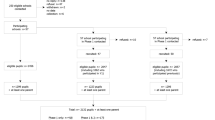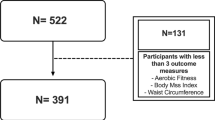Abstract
Objective:
There is currently wide interest in the physical activity of children, but little understanding of its control. Here, we use accelerometers to test the hypothesis that habitual activity in young children is centrally, rather than environmentally, regulated. By central regulation we mean a classic biological feedback loop, with a set-point individual to the child, which controls his/her activity independently of external factors.
Design:
Non-intervention, observational and population-based, set in the home and at school.
Results:
Girls were systematically less active than boys, and both weekday/weekend day and year-on-year activities were correlated (r=0.43–0.56). A fivefold variation in timetabled PE explained less than 1% of the total variation in physical activity. The activity cost of transport to school was only 2% of total activity, but over 90% of it was recovered elsewhere in the day. The weekly activity recorded by children in Plymouth was the same (to within <0.3%) as that recorded independently in Glasgow, 800 km away. Total daily activity was unrelated to time reportedly spent watching TV.
Interpretation:
The correlations within groups and the similarities between them suggest that physical activity in children is under central biological regulation. There are implications both for public health planners and for the potentially novel signalling pathways involved.
This is a preview of subscription content, access via your institution
Access options
Subscribe to this journal
Receive 12 print issues and online access
$259.00 per year
only $21.58 per issue
Buy this article
- Purchase on Springer Link
- Instant access to full article PDF
Prices may be subject to local taxes which are calculated during checkout

Similar content being viewed by others
References
Joliffe N . The appestat; the appetite-regulating mechanism. Merck Rep 1952; 61: 3–7.
Goldstone AP . Prader-Willi syndrome: advances in genetics, pathophysiology and treatment. Trends Endocrinol Metab 2004; 15: 12–20.
Montague CT, Farooqi IS, Whitehead JP, Soos MA, Rau H, Wareham NJ et al. Congenital leptin deficiency is associated with severe early-onset obesity in humans. Nature 1997; 387: 903–908.
Voss LD, Kirkby J, Metcalf BS, Jeffery AN, O’Riordan C, Murphy MJ et al. Preventable factors in childhood that lead to insulin resistance, diabetes mellitus and the metabolic syndrome (EarlyBird 1). J Pediatr Endocrinol Metab 2003; 16: 1211–1224.
Mallam KM, Metcalf BS, Kirkby J, Voss LD, Wilkin TJ . Contribution of timetabled physical education to total physical activity in primary school children: cross sectional study. BMJ 2003; 327: 592–593.
Reilly JJ, Jackson DM, Montgomery C, Kelly LA, Slater C, Grant S et al. Total energy expenditure and physical activity in young Scottish children: mixed longitudinal study. Lancet 2004; 363: 211–212.
Westerterp KR . Physical activity assessment with accelerometers. Int J Obes Relat Metab Disord 1999; 23 (Suppl 3): S45–S49.
Metcalf BS, Curnow JS, Evans C, Voss LD, Wilkin TJ . Technical reliability of the CSA activity monitor: The EarlyBird Study. Med Sci Sports Exerc 2002; 34: 1533–1537.
Metcalf BS, Voss LD, Wilkin TJ . Accelerometers identify inactive and potentially obese children (EarlyBird 3). Arch Dis Child 2002; 87: 166–167.
Hancox RJ, Milne BJ, Poulton R . Association between child and adolescent television viewing and adult health: a longitudinal birth cohort study. Lancet 2004; 364: 257–262.
Dietz WH, Gortmaker SL . TV or not TV: fat is the question. Pediatrics 1993; 91: 499–501.
Katzmarzyk PT, Malina RM, Song TM, Bouchard C . Television viewing, physical activity, and health-related fitness of youth in the Quebec Family Study. J Adolesc Health 1998; 23: 318–325.
Robinson TN, Hammer LD, Killen JD, Kraemer HC, Wilson DM, Hayward C et al. Does television viewing increase obesity and reduce physical activity? Cross-sectional and longitudinal analyses in adolescent girls. Pediatrics 1993; 91: 273–280.
Wilkin TJ . Endocrine feedback control in health and disease. In: Bittar EE, Bittar N (eds). The Principles of Medical Biology. JAI Press Inc: Greenwich, CT, 1998. pp 1–28.
Sleap M, Tolfrey K . Do 9- to 12 year-old children meet existing physical activity recommendations for health? Med Sci Sports Exerc 2001; 33: 591–596.
Rowe N, Champion R . Young People and Sport National Survey 1999. Sport England:London, 2000.
Kelly LA, Reilly JJ, Fisher A, Montgomery C, Williamson A, McColl JH et al. Effect of socioeconomic status on objectively measured physical activity. Arch Dis Child 2006; 91: 35–38.
Lightfoot JT, Turner MJ, Daves M, Vordermark A, Kleeberger SR . Genetic influence on daily wheel running activity level. Physiol Genomics 2004; 19: 270–276.
Joosen AM, Gielen M, Vlietinck R, Westerterp KR . Genetic analysis of physical activity in twins. Am J Clin Nutr 2005; 82: 1253–1259.
Trost SG, Ward DS, Moorehead SM, Watson PD, Riner W, Burke JR . Validity of the computer science and applications (CSA) activity monitor in children. Med Sci Sports Exerc 1998; 30: 629–633.
Rowland TW . The biological basis of physical activity. Med Sci Sports Exerc 1998; 30: 392–399.
http://www.sportengland.org/condition_and_refurbishment_2002_final_report.pdf.
Schmitz KH, Jacobs Jr DR, Hong CP, Steinberger J, Moran A, Sinaiko AR . Association of physical activity with insulin sensitivity in children. Int J Obes Relat Metab Disord 2002; 26: 1310–1316.
Brage S, Wedderkopp N, Ekelund U, Franks PW, Wareham NJ, Andersen LB et al. Objectively measured physical activity correlates with indices of insulin resistance in Danish children. The European Youth Heart Study (EYHS). Int J Obes Relat Metab Disord 2004; 28: 1503–1508.
Acknowledgements
Grants: The study was supported by grants from Diabetes UK, S&SW NHS Executive R&D, The Diabetes Foundation and the Child Growth Foundation. We gratefully acknowledge further help from Roche Products, Smith's Charity, Abbott Laboratories, Ipsen, GSK, Astra-Zeneca, Unilever and the Beatrice-Laing Foundation.
Author information
Authors and Affiliations
Additional information
Contributions: TJW conceived the EarlyBird study, the Three Schools Study and the Activitystat Hypothesis. KMM undertook the Three Schools Study. BSM was responsible for statistical analysis and ANJ for much of the data collection from the EarlyBird study. LDV is supervisor of the EarlyBird study.
Rights and permissions
About this article
Cite this article
Wilkin, T., Mallam, K., Metcalf, B. et al. Variation in physical activity lies with the child, not his environment: evidence for an ‘activitystat’ in young children (EarlyBird 16). Int J Obes 30, 1050–1055 (2006). https://doi.org/10.1038/sj.ijo.0803331
Published:
Issue Date:
DOI: https://doi.org/10.1038/sj.ijo.0803331
Keywords
This article is cited by
-
Continuous-time modeling of the multivariate relationships between physical activity levels and stationary time in preschool-aged children: an investigation of the ActivityStat hypothesis
Journal of Activity, Sedentary and Sleep Behaviors (2023)
-
trips4health: a single-blinded randomised controlled trial incentivising adult public transport use for physical activity gain
International Journal of Behavioral Nutrition and Physical Activity (2023)
-
Exploring activity compensation amongst youth and adults: a systematic review
International Journal of Behavioral Nutrition and Physical Activity (2022)
-
Testing the activitystat hypothesis: a randomised controlled trial
BMC Public Health (2016)
-
In-school versus out-of-school sedentary behavior patterns in U.S. children
BMC Obesity (2016)



